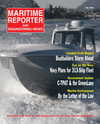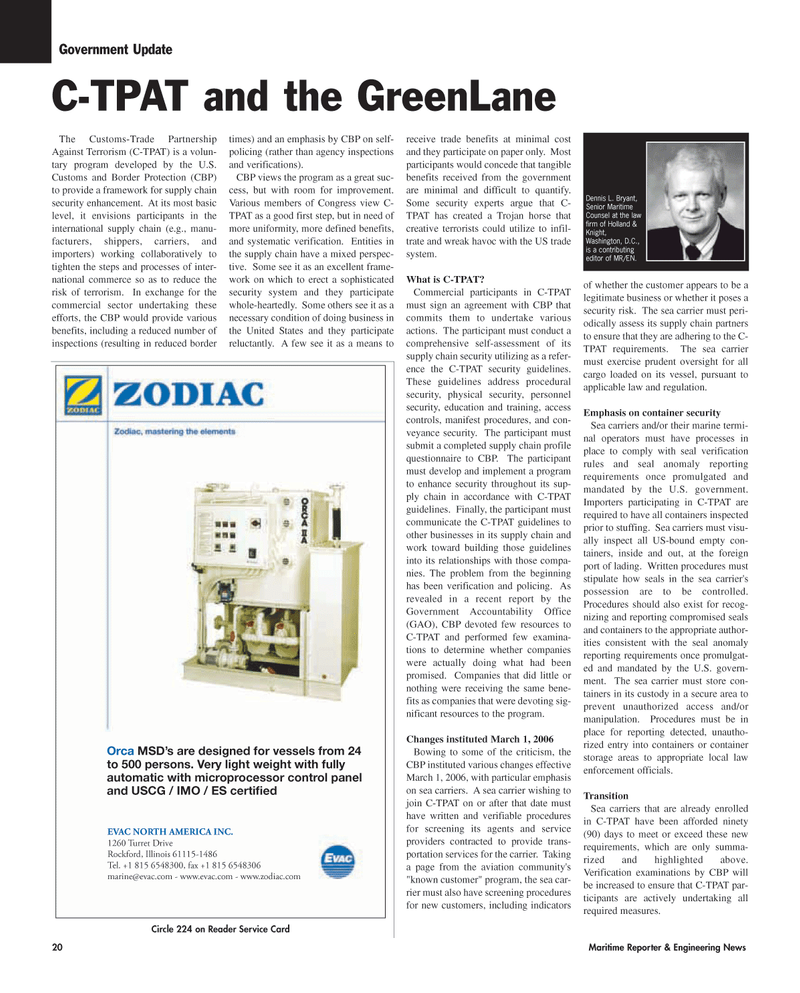
Page 20: of Maritime Reporter Magazine (May 2006)
The Marine Enviroment
Read this page in Pdf, Flash or Html5 edition of May 2006 Maritime Reporter Magazine
20 Maritime Reporter & Engineering News
The Customs-Trade Partnership
Against Terrorism (C-TPAT) is a volun- tary program developed by the U.S.
Customs and Border Protection (CBP) to provide a framework for supply chain security enhancement. At its most basic level, it envisions participants in the international supply chain (e.g., manu- facturers, shippers, carriers, and importers) working collaboratively to tighten the steps and processes of inter- national commerce so as to reduce the risk of terrorism. In exchange for the commercial sector undertaking these efforts, the CBP would provide various benefits, including a reduced number of inspections (resulting in reduced border times) and an emphasis by CBP on self- policing (rather than agency inspections and verifications).
CBP views the program as a great suc- cess, but with room for improvement.
Various members of Congress view C-
TPAT as a good first step, but in need of more uniformity, more defined benefits, and systematic verification. Entities in the supply chain have a mixed perspec- tive. Some see it as an excellent frame- work on which to erect a sophisticated security system and they participate whole-heartedly. Some others see it as a necessary condition of doing business in the United States and they participate reluctantly. A few see it as a means to receive trade benefits at minimal cost and they participate on paper only. Most participants would concede that tangible benefits received from the government are minimal and difficult to quantify.
Some security experts argue that C-
TPAT has created a Trojan horse that creative terrorists could utilize to infil- trate and wreak havoc with the US trade system.
What is C-TPAT?
Commercial participants in C-TPAT must sign an agreement with CBP that commits them to undertake various actions. The participant must conduct a comprehensive self-assessment of its supply chain security utilizing as a refer- ence the C-TPAT security guidelines.
These guidelines address procedural security, physical security, personnel security, education and training, access controls, manifest procedures, and con- veyance security. The participant must submit a completed supply chain profile questionnaire to CBP. The participant must develop and implement a program to enhance security throughout its sup- ply chain in accordance with C-TPAT guidelines. Finally, the participant must communicate the C-TPAT guidelines to other businesses in its supply chain and work toward building those guidelines into its relationships with those compa- nies. The problem from the beginning has been verification and policing. As revealed in a recent report by the
Government Accountability Office (GAO), CBP devoted few resources to
C-TPAT and performed few examina- tions to determine whether companies were actually doing what had been promised. Companies that did little or nothing were receiving the same bene- fits as companies that were devoting sig- nificant resources to the program.
Changes instituted March 1, 2006
Bowing to some of the criticism, the
CBP instituted various changes effective
March 1, 2006, with particular emphasis on sea carriers. A sea carrier wishing to join C-TPAT on or after that date must have written and verifiable procedures for screening its agents and service providers contracted to provide trans- portation services for the carrier. Taking a page from the aviation community's "known customer" program, the sea car- rier must also have screening procedures for new customers, including indicators of whether the customer appears to be a legitimate business or whether it poses a security risk. The sea carrier must peri- odically assess its supply chain partners to ensure that they are adhering to the C-
TPAT requirements. The sea carrier must exercise prudent oversight for all cargo loaded on its vessel, pursuant to applicable law and regulation.
Emphasis on container security
Sea carriers and/or their marine termi- nal operators must have processes in place to comply with seal verification rules and seal anomaly reporting requirements once promulgated and mandated by the U.S. government.
Importers participating in C-TPAT are required to have all containers inspected prior to stuffing. Sea carriers must visu- ally inspect all US-bound empty con- tainers, inside and out, at the foreign port of lading. Written procedures must stipulate how seals in the sea carrier's possession are to be controlled.
Procedures should also exist for recog- nizing and reporting compromised seals and containers to the appropriate author- ities consistent with the seal anomaly reporting requirements once promulgat- ed and mandated by the U.S. govern- ment. The sea carrier must store con- tainers in its custody in a secure area to prevent unauthorized access and/or manipulation. Procedures must be in place for reporting detected, unautho- rized entry into containers or container storage areas to appropriate local law enforcement officials.
Transition
Sea carriers that are already enrolled in C-TPAT have been afforded ninety (90) days to meet or exceed these new requirements, which are only summa- rized and highlighted above.
Verification examinations by CBP will be increased to ensure that C-TPAT par- ticipants are actively undertaking all required measures.
Orca MSD’s are designed for vessels from 24 to 500 persons. Very light weight with fully automatic with microprocessor control panel and USCG / IMO / ES certified
EVAC NORTH AMERICA INC. 1260 Turret Drive
Rockford, Illinois 61115-1486
Tel. +1 815 6548300, fax +1 815 6548306 [email protected] - www.evac.com - www.zodiac.com
Circle 224 on Reader Service Card
Government Update
C-TPAT and the GreenLane
Dennis L. Bryant,
Senior Maritime
Counsel at the law firm of Holland &
Knight,
Washington, D.C., is a contributing editor of MR/EN.
MR MAY2006 #3 (17-24).qxd 5/8/2006 11:23 AM Page 20

 19
19

 21
21
